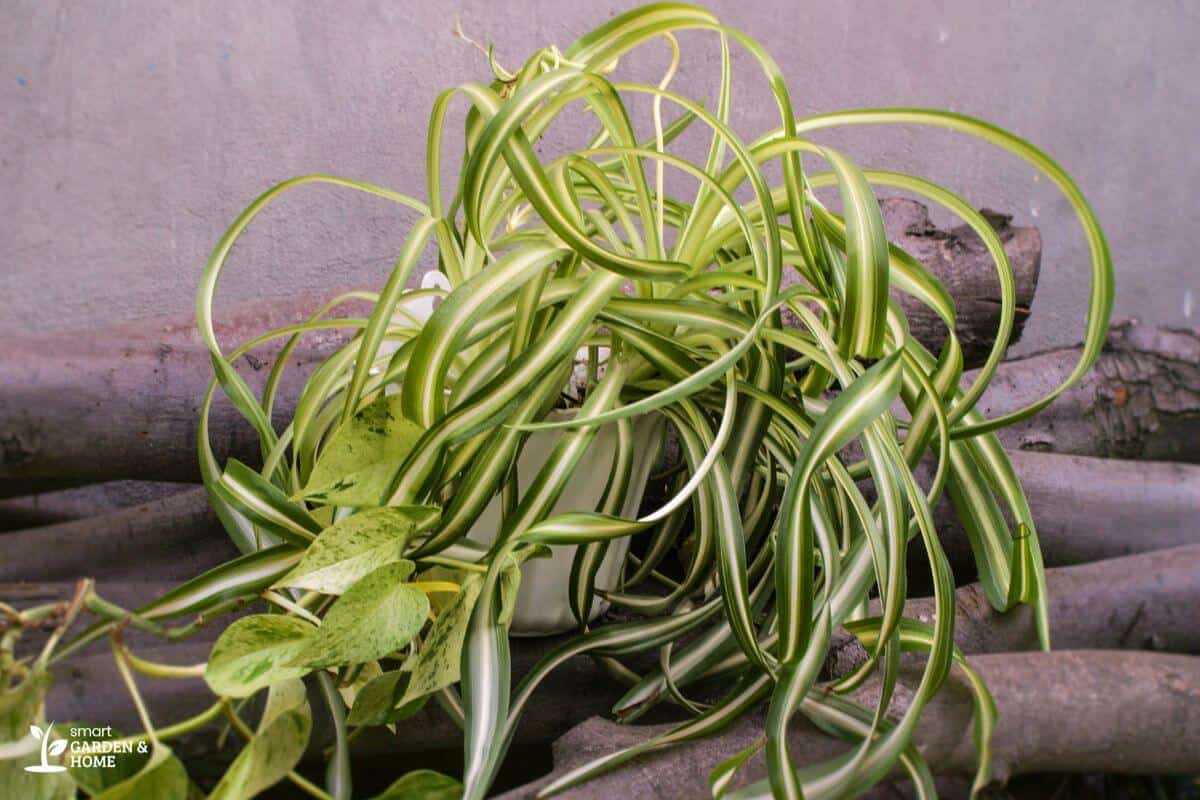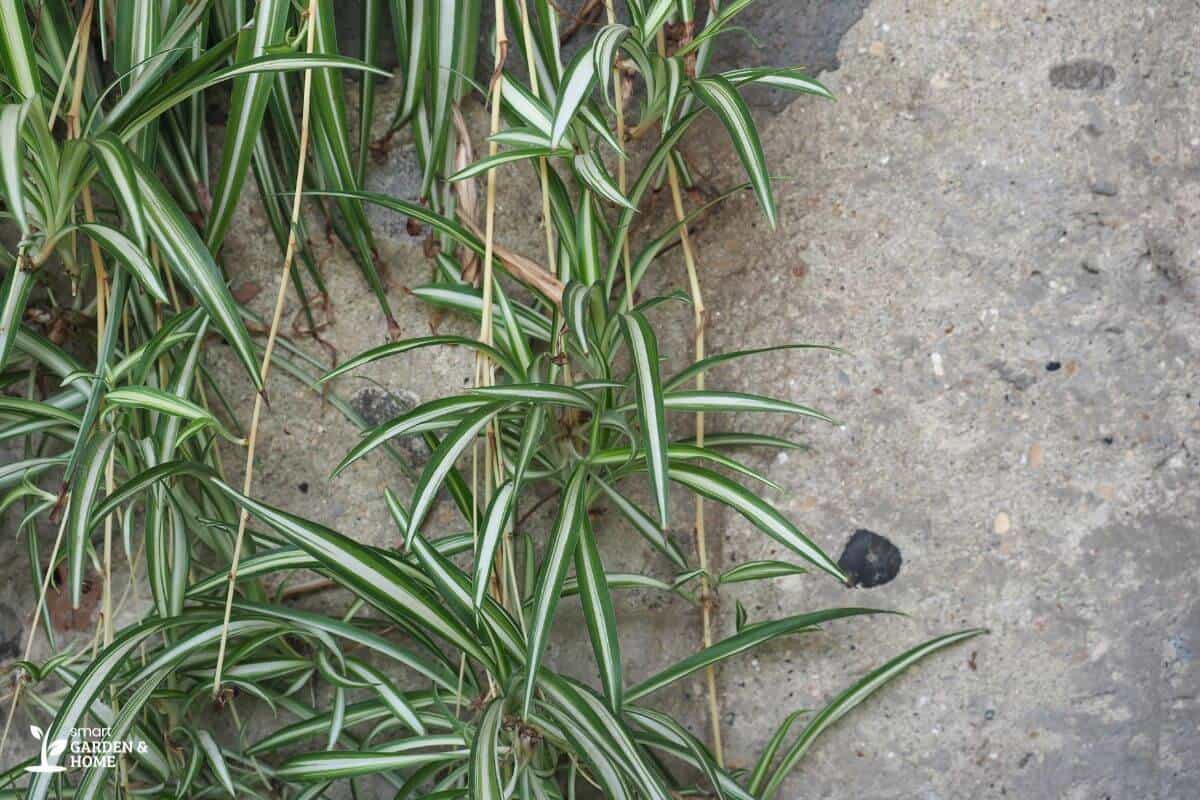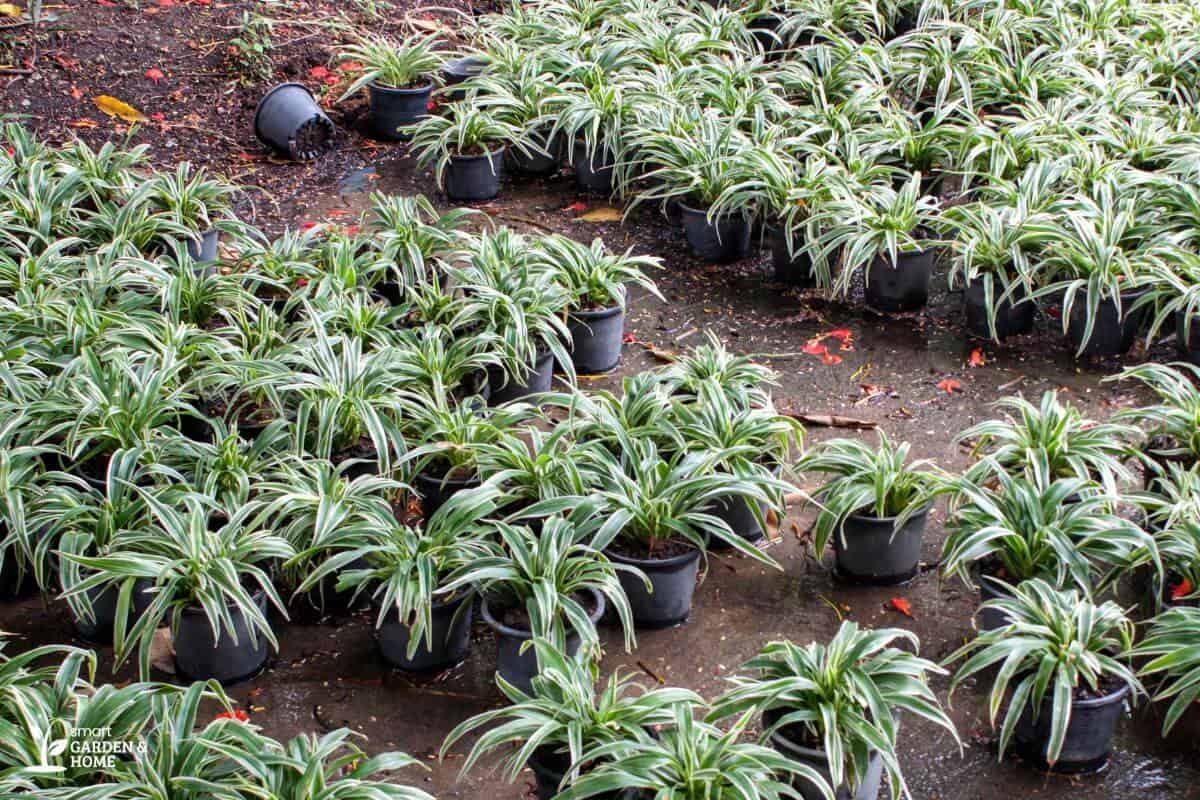Pruning spider plants (Chlorophytum comosum) is easier than it may seem and it is a necessary step in helping your plant to grow healthy and not just beautiful.
It will also decrease the size of spider plants, making them more manageable to handle.
Spider Plant leaves should be pruned once a year in the warm season by removing all unhealthy-looking leaves. It’s also possible to cut off the spiderettes and use them to propagate your plant.
- Related article: Growing a Spider Plant
Read on for more information on why, when, and how to prune your spider plant.
Why Trim Spider Plant Leaves?

Chlorophytum comosum can benefit from good pruning for many reasons.
Here are the main ones:
1. Pruning spider plants keeps them at a manageable size.
2. Spider plants may become leggy if not trimmed regularly.
3. The bigger the spider plant is, the more energy it will need so you’ll have to provide it with more fertilizer and more water.
4. Spider plants are rejuvenated when pruned and their health and vigor are improved.
5. Pruning may help spider plants grow quicker.
6. The overall appearance of the plant improves with regular trimming.
7. Pests such as mealybugs can hide in between the dead leaves if they aren’t removed.
When to Prune Spider Plant Leaves

Spider plants should be pruned once a year to ensure they grow healthy and strong.
The best time to trim the leaves is the growing season so that the plant will have enough energy to sustain stress. You can trim your spider plant both during spring and summer.
Apart from the leaves, it’s also advisable to trim the spiderettes, which are the little plantlets that grow at the bottom of their long dangling stems.
These baby spider plants may look beautiful, but they can take up most of the energy of the mother plant.
So if you want your plant to grow in size, regularly removing the baby spiderettes will help. Moreover, these can then be planted in fresh soil or water and they will grow into new spider plants.
Not many people know this, but the roots of spider plants should also be pruned. Root pruning benefits this plant as they are very sensitive to root rot.
Check your plant for any dark and mushy roots and remove them. This should be done about every two years.
How to Prune Spider Plant Leaves
Regular pruning of spider plants is easier than it might seem.
Just follow these simple steps for a healthy spider plant:
1. Clean and Sterilize a Pair of Pruning Shears or Pair of Scissors
You should always start by washing your tools with water and soap. After which, you can wipe them with rubbing alcohol or a standard household cleaner to sterilize them.
Another option is to soak your cutting tools in a 10% bleach solution. Do not do this often and for too long though as it will risk corroding the blades about 30 minutes during each soak should be fine.
This step is to minimize the risk of using contaminated tools, minimize the spread of disease, and avoid the transfer of parasites from one plant to another.
2. Cut Away Any Yellow or Brown Leaves
Unhealthy leaves that look dead, discolored or with disease should be trimmed very close at the base of the plant.
You might want to save most of your spider plant and trim only the part that appears sickly or is damaged. However, doing so will only leave an open wound on the plant that can result in an infection or attract pests.
A common problem of spider plants is brown tips. If the damaged part is small and localized, you could try to only remove the tip instead of the whole leaf. In this case, the cut should be made on the brown part and not on the healthy one.
3. Remove Spiderettes

The baby spider plants should be clipped close to the base of the mother plant. The long stem that will remain attached to the spiderettes can then be removed as well, clipping as close to the plant as possible.
Spiderettes can be propagated to grow new spider plants. The easiest way is to place them in a container with water until they form new roots. After that, they can be planted in the soil.
You can also transplant spiderettes in moist soil and give it bright indirect sunlight but this will take them a longer time to grow roots as compared to being placed in water.
Avoid direct sunlight at all costs as these baby plants are still very sensitive.
4. Prune the Roots
Trimming the roots of your spider plant will benefit its overall health as long as you’re careful not to cut too much. The general idea is to remove any parts that may be rotten, which is a common problem for this specie.
The roots should be trimmed by about 1 inch. You won’t need to do this every time you prune your spider plant, just every two years will be enough.
5. Repot Your Spider Plant
When you are done pruning yet your plant still seems to be out of proportion, overgrown, or with roots emerging from the soil, it could be time for a repot.
Make sure to choose a well-draining potting mix because this plant does not like to sit on wet feet. Also, pick a pot that is one inch bigger than the previous pot to encourage growth.
We have a more detailed article on how to repot spider plants so make sure to check that out.
Spider Plant Pruning and Trimming Tips

Following are some final tips and tricks on pruning spider plants:
1. When pruning, always start at the base of the spider plant and work your way outwards.
2. If your spider plant is too leggy, you can cut some of the healthy leaves and dead foliage near the base of the plant. Spider plants are very hardy so they won’t be hurt. They will instead be stimulated to become bushier.
3. If you end up removing a large part of the foliage, you should skip the following year’s pruning.
4. Some brown leaves may easily come away when pulled. You can remove them this way but whenever you feel some resistance it’s best to cut them rather than pull them.
If your plant has many brown or yellow leaves, you may want to investigate possible causes, such as water or soil quality and amount of sunlight.
Final Thoughts on Spider Plant Pruning
Pruning spider plants is a straightforward process that requires some basic tools.
Clean and sterilize your pruning shears before cutting away any damaged leaves and baby plants, and trim the roots of your spider plant every two years. Repotting may be necessary after a major pruning session.
Following these steps can help you keep your spider plant healthy, vibrant, and beautiful! Read these other amazing articles to learn more:
- How to Make Spider Plant More Bushy
- Spider Plant in Aquarium
- Spider Plant in Water
- Outdoor Plant That Looks Like Spider Plant
- Benefits of Spider Plant
Sources:

